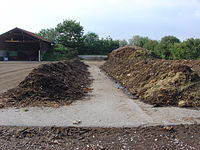
Photo from wikipedia
Cropping soils vary in extent of natural suppression of soil-borne plant diseases. However, it is unknown whether similar variation occurs across pastoral agricultural systems. We examined soil microbial community properties… Click to show full abstract
Cropping soils vary in extent of natural suppression of soil-borne plant diseases. However, it is unknown whether similar variation occurs across pastoral agricultural systems. We examined soil microbial community properties known to be associated with disease suppression across 50 pastoral fields varying in management intensity. The composition and abundance of the disease-suppressive community were assessed from both taxonomic and functional perspectives. Pseudomonas bacteria were selected as a general taxonomic indicator of disease suppressive potential, while genes associated with the biosynthesis of a suite of secondary metabolites provided functional markers (GeoChip 5.0 microarray analysis). The composition of both the Pseudomonas communities and disease suppressive functional genes were responsive to land use. Underlying soil properties explained 37% of the variation in Pseudomonas community structure and up to 61% of the variation in the abundance of disease suppressive functional genes. Notably, measures of soil organic matter quality, C:P ratio, and aromaticity of the dissolved organic matter content (carbon recalcitrance), influenced both the taxonomic and functional disease suppressive potential of the pasture soils. Our results suggest that key components of the soil microbial community may be managed on-farm to enhance disease suppression and plant productivity.
Journal Title: PLoS ONE
Year Published: 2018
Link to full text (if available)
Share on Social Media: Sign Up to like & get
recommendations!